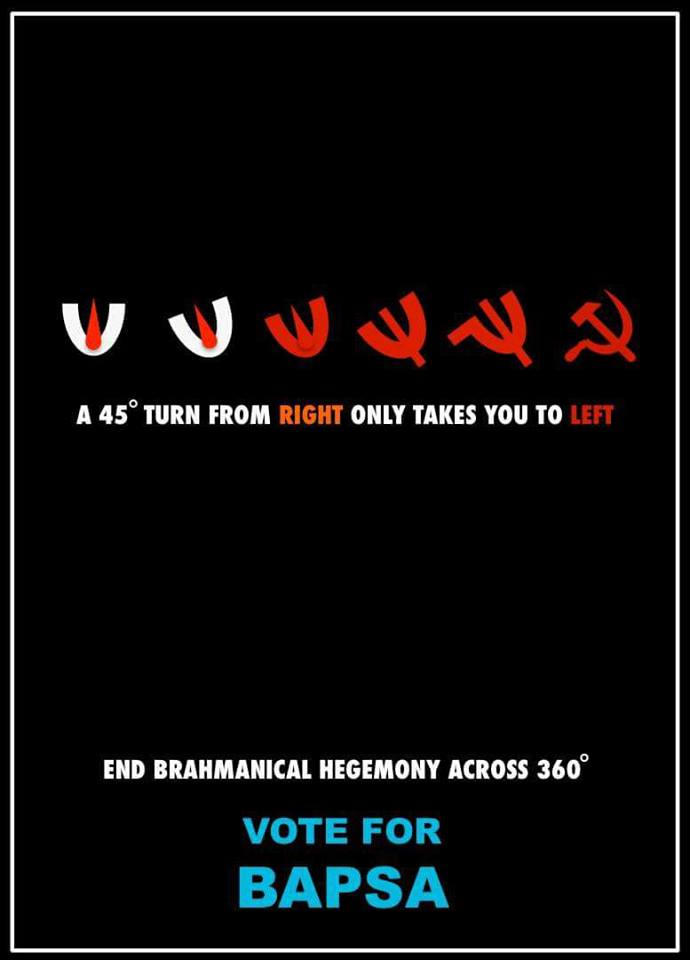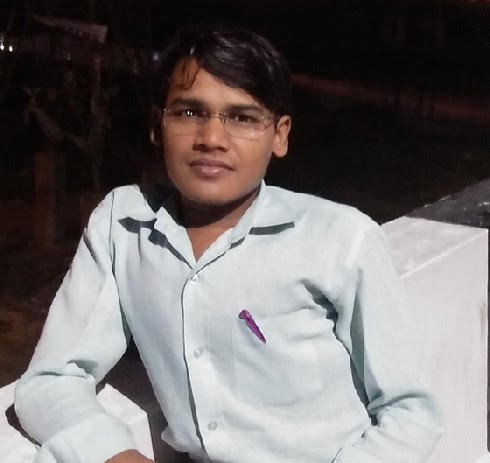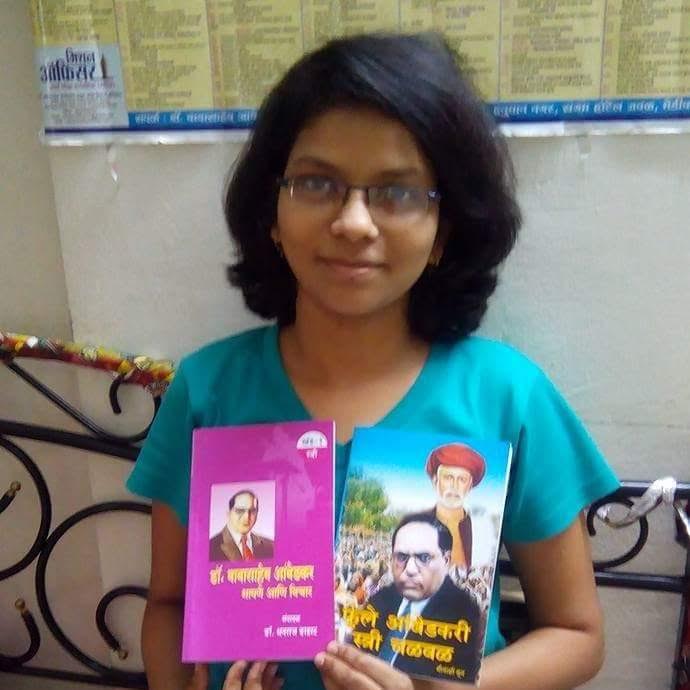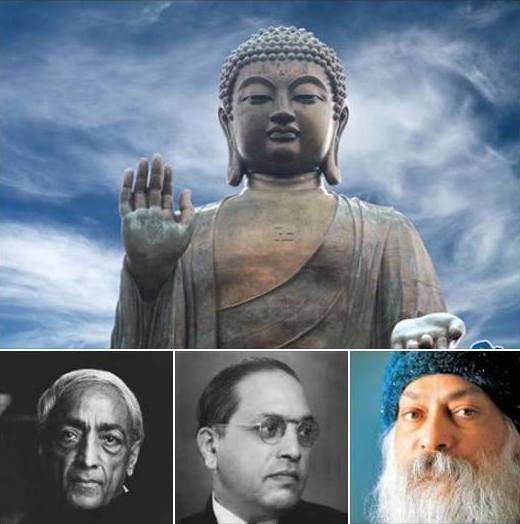Shubhi
“The Brahmins form the vanguard of the movement for political reform, and in some cases also of economic reform. But they are not to be found even as camp-followers in the army raised to break down the barricades of Caste. Is there any hope of the Brahmins ever talking up a lead in the future in this matter? I say no. It is useless to make distinction between the secular Brahmins and priestly Brahmins. Both are kith and kin. They are two arms of the same body, one is bound to fight for the existence of the other”. ~Dr. Bhim Rao Ambedkar in Annihilation of Caste,1936.

Brahminism and the Brahmin in India have survived through different labels (state, government, seculars, liberals, left, ruling class, capitalist, class, ‘Indian nationalists’, Hindutva, feminism, colonialism, ‘elite nationalism’, Congress, BJP, Indian academics, social scientists etc), and as a result has been able to hide its Hindu religious core. Left politics in India has masked its Brahminical face in the name of critiquing Hindutva thus concealing its complicity in upholding Brahminism. Hindutva due to its extremely violent tendencies in the name of the nation, nationalism has almost created an illusion of Hindu religion as benign. Hindutva has basically done service to Brahminism making people believe that Hindu religion is their personal faith and has nothing to do with the violence that Hindutva endorses. But this is a myth; it is this personal Hindu faith or religion which endorses caste dictated purity-pollution norms which is horrifically oppressive to lower castes. Hindu religious texts are filled with horrific violence and bloodshed of Bahujans. This division of Hindu religion being different from Hindutva has masked the exploitative nature of Hindu religion apart from other factors. Hindutva masked Hinduism. Hindutva originators are none other than Brahmins like V.D. Savarkar, Hedgewar and M.S Golwalkar.
The entire JNU left political and academic discourse is sustained only through Hindutva critique which helps in letting the Hindu religion (source of the evil of caste) go unquestioned and in turn facilitates a ‘Hindu-Hindutva’ binary. This pseudo binary is necessary to deflect the attention from caste oppression embedded in various Hindu religious scriptures. It is like ABVP is necessary for the survival of the Left in JNU. What else can explain the coming together of different shades of Left in the campus after the arrival of BAPSA on the campus? Though ABVP existed before BAPSA. This Hindutva–Hindu binary has preserved the caste structure, reproduced and strengthened it. Brahmins under various labels give the impression of being critical of each other but basically, reflect a survival strategy to maintain Brahminical hegemony. This desire to maintain Brahminical hegemony is reflected in the way Indian academia has talked about the exploitation of the masses by relegating it to class oppression and any struggle if they take up in the name of caste would be utterly futile for it will purely be an appropriation. In the paragraph below Ambedkar explains about this academic treachery:
“You may think it a pity that the intellectual class in India is simply another name for the Brahmin caste. You may regret that the two are one; that the existence of intellectual class should be bound up with one single caste; that this intellectual class should share the interest and aspiration of that Brahmin caste, and should be a class which has regarded itself as the custodian of the interest of that caste, rather than of the country. All this may be very regrettable. But the fact remains that the Brahmins form the intellectual class of the Hindus. It is not only an intellectual class, but it is a class which is held in great reverence by the rest of the Hindus”…. When such an intellectual class, which holds the rest of the community in its grip, is opposed to the reform of Caste, the chances of success in a movement for the break-up of the Caste system appear to me very, very remote”. (B.R Ambedkar, 1936)
It is caste solidarity that has led to the neglect of Ambedkar’s writings in the campus till date. Ambedkar’s writings are of immense threat to JNU professors and this is the reason why none have been able to elaborate the way Ambedkar has explained about the ‘origin of caste’, for that will threaten the caste privilege of these professors and as a result have given a class explanation under ‘Marxist bent’ or ended up valorizing caste by imitating Western theorists. Questioning this caste blindness, Ambedkar argues that “caste is not just a division of labour, it is a division of labourers…..in which division of labourers are graded one above the other. In no other country is the division of labour accompanied by this gradation of labourers” (B.R. Ambekar, 1936). This suggests that oppression cannot be homogenized as it is graded inequality and not just inequality. Ambedkar through his incisive caste analysis showed the futility of Marxian class ideology in ending exploitation in India. He writes:
“To excite the proletariat to bring about an economic revolution, Karl Marx told them: ‘You have nothing to lose except your chains’. But the artful way in which the social and religious rights are distributed among the different castes, whereby some have more and some have less, makes the slogan of Karl Marx quite useless to excite the Hindus against the caste system. Castes form a graded system of sovereignties, high and low, which are jealous of their status and which know that is a general dissolution came, some of them stand to lose more of their prestige and power than others do. You cannot, therefore, have a general mobilization of the Hindus (to use a military expression) for an attack on the Caste system” (B.R. Ambedkar, 1936).
Marxism has been contorted to give Savarna intellectuals a caste-less avatar. Class has been pressed into the service of caste. Class masks the caste interconnectedness of the oppressor. Undoubtedly Savarna politicians and academicians exploited even Marx who wanted to end the exploitation. Continuing this bid to keep the Brahmin hegemony intact savarna academicians went one step ahead and popularized ‘caste and class’, as two separate categories in explaining exploitation thus absolving them from the sin of not questioning caste. The idea behind this was to deflect the attention from the original oppressor (caste) even while talking about it in order to preserve their caste privileges.
The next favourite tool of the Brahmin in maintaining caste hegemony was and is appropriation. Both ABVP and LEFT (with various superficial labels in the campus) appropriated well to corner Bahujan votes by chanting Ambedkar’s name, adding his photos along with its leaders similar to those of BJP’s appropriation of Ambedkar. Left which not only called caste as class further made it class and caste is now chanting ‘Jai Bhim’ and having an organization with Ambedkar’s name in it (BASO) shows its superficial engagement with Ambedkar’s ideas which further exposes its Brahmincal roots. Appropriation is the best way to engage with caste for it will hide the appropriator’s caste as well as give the benefit of engaging with the caste question. How else can we understand the inclusion of ‘Jai Bhim’ in JNU campus very recently? Savarna under various labels appropriate to dismantle the unity of the oppressed as it is a threat to their caste hegemony.
Everyone is under the impression that it is Hindutva which is the reason behind mob lynching but this is wrong. The phenomenon of mob lynching that continues in the name of beef has its roots in the Hindu religion and not in Hindutva. Or else what can explain that any random mob is engaged in lynching and the spectators are doing nothing. Who are these spectators? Why are they letting the killers go in the name of cow protection? The reverence for the cow in Hindu psyche has its roots in the Hindu religion itself. This reverence for cows among Hindus could be inferred from the way prohibition of cow slaughter law had to be incorporated under the Directive Principles of the state policy. Though, very shrewdly many have put the blame on Ambedkar for its inclusion in the Constitution which is again a futile attempt to malign him. It was under the Congress Regime the pressure from the Brahmin ministers was such that Dr. Ambedkar could not all together reject the question of cow protection given the linkages between cow and untouchability which he explained. The choice for him was to either include it as fundamental right or as directive principle. Dr. Ambedkar’s farsightedness has prevented cow slaughter ban from becoming a fundamental right thus stopped from becoming enforceable whereas by making it a directive principle it is non-justiciable, though an enabling provision. At that time debates were rife with religious sentiments. “This is part of our religion. The cow should be protected from slaughter and therefore we want its provision either in the Fundamental Rights or in the Directive Principles’ stressed one member of the Constituent Assembly. Seth Govind Das, a member of the Constituent Assembly, framed it as a ‘civilisational (problem) from the time of lord Krishna, he wanted the prohibition of cow slaughter to be made part of the fundamental rights…….In this, he was supported by other members of the Constituent Assembly, such as Shibban Lal Saxena, Thakur Das Bhargava, Ramnarayan Singh, Ram Sahai, Raghu Vira, R.V Dhulekar and Chaudhri Ranbir Singh” (Gautam Bhatia, 2017).
The point here is that various labels create an illusion of difference but the core of these labels is composed of Brahmins only. This very fact is reiterated again and again by Ambedkar when he talks about the governing class, intellectual class, Congress and Hindu Mahasabha. For instance, Ambedkar in Pakistan or the Partition of India, writes:
“the theory of nationality is imbedded in the democratic theory of the sovereignty of the will of the people. This means that the demand by a nationality for a national state does not require to be supported by any list of grievances. The will of the people is enough to justify it. But if, grievances must be cited in support of their claim, the Muslims say that they have them in plenty. They may be summed up in one sentence, that constitutional safeguards have failed to save them from the tyranny of the Hindu majority…..it is no use saying that the Congress is not a Hindu body. A body which is Hindu is conception is bound to reflect the Hindu mind and support Hindu aspirations. The only difference between the Congress and the Hindu Maha Sabha is that the latter is crude in its utterances and brutal in its actions while the Congress is politic and polite. Apart from this difference of fact, there is no difference between Congress and Hindu Maha Sabha”. (B.R. Ambedkar, 1941)
The argument is that Brahmin might differ in crudity but its essence remains same, exploitative.
There is no doubt that manual scavenging, prostitution, endogamy existed even before Hindutva but shamelessly the savarna academicians have relegated the cause for these to class factor. Brahminical traits camouflaged as left, radical, progressive can be evident in the way they talk about gender like all ‘women are oppressed’, then suddenly taking up lower caste women issues and talk about how they are so oppressed due to their back breaking labour. It is essentially a class analysis of oppression without which they cannot shield their own caste and their complicity in maintaining the caste structure. Ambedkar stressed that except Brahmins “all are slaves of the Caste system. But all the slaves are not equal in status”. (B.R. Ambedkar, 1936). But then, caste privileges are too hard to let go. By talking about Dalit women and calling that all women are oppressed, they are just blurring the difference of caste. But I am surprised that they are still stuck with this savarna feminist class analysis despite some savarna feminists in order to be academic and politically relevant, and given the sustained critique by Dalit Bahujan women of their caste blindness were forced to change their discourse. It is in these upper caste women’s houses that the lower caste women work as maids, cleaners, then how can they say that all women are oppressed equally? Upper caste women’s caste status saves them from back breaking labour or even domestic labour which is then forced on Dalit Bahujan women. Dalit Bahujan labour give savarna leisure time which they use in exploiting these masses by writing on them distorting their narratives which further keeps their subjugation intact and permanently reproduced. This vicious circle continues to grow and becomes more complex but remains hidden as the savarna put the onus on government and state to take care of laboring lower caste masses. This is again a strategy to deflect caste, for the government is not an abstract identity having no caste. Ambedkar clearly stated that governing class in India is nothing but Brahmins only. ABVP has Tripathi domination and present LEFT party has Pandey as president.
The Brahmin-Savarna will never let go of the privileges which it enjoys due to its caste and will neither reveal it, for their caste position ensures them incessant labour which further reproduces caste. These ‘various shades of Brahmanism’ insist and maintain that ‘it is good to be Hindu but not Hindutvavadis’. Hindutva is nothing but an extension of Hinduism. Is Hindutva definition of nationalism any where different from Savarna belief in unquestioned supremacy of Indian cultural tradition, beliefs and, values? How is the nation imagined by Hindutva any different from Brahmin nation? Hindutva is nothing “but the restructuring of Brahminical hegemony” in the name of nation. This hiding of the Brahmin self in the name of nation “was a tactic to prohibit the growing Dalit movement and to sabotage it because of its articulations against caste, the scientific arguments deployed by dalits and their protests had attained visible prominence. With the remarkable entry of Dr, B.R. Ambedkar into the social and political domain, conservative brahmins had shrunk in fear and has started to reconceptualise the trajectories to accommodate maximum possible number of Hindus (who were divided across castes) into Hindutva, so as to create a substantial following for Brahmin political/social/cultural leadership” (Yogesh Maitreya, 2015). The Left’s imagination of nation was no different from Gandhi and Hindutva as is clear from E.M.S Namboodripad’s reaction to Poona Pact in 1932, reflecting his Brahminical anxieties though he called ‘Gandhi as Hindu Fundamentalist’. He wrote:
“This was a great blow to the freedom movement. For this led to the diversion of people’s attention from the objective of full independence to the mundane cause of the upliftment of the Harijans”.
Clearly, the ‘Brahmin-Baniya’ were playing around with superficial differences while maintaining a consensus on the futility of untouchable question. This reminds us of Ambedkar’s belief that there can be no possibility of a nation in a caste ridden society. He poignantly mentions this:
“Caste prevents Hindus from forming a real society or nation….. the first and foremost thing that must be recognized is that Hindu society is a myth. The name Hindu is itself a foreign name. It was given by the Mohammedans to the natives for the purpose of distinguishing themselves (from them). It does not occur in any Sanskrit work prior to the Mohammedan invasion. They did not feel the necessity of the common name, because they had no conception of their having constituted a community. Hindu society as such does not exist. It is only a collection of castes. Each caste is conscious of its own existence……A caste has no feeling that it is affiliated to other castes, except when there is a Hindu-Muslim riots. On all other occasions each caste endeavours to segregate itself and to distinguish itself from other castes” (B.R. Ambedkar, 1936).
In the above passage, Ambedkar has not only highlighted caste as the core of so the called Indian nation which was not only the reality at his time but today also. Another tendency of the ‘Brahmincal whole’ he highlighted is that an untouchable’s existence is realized only at the time of Hindu-Muslim riots. Basically, Savarna academics and political groups can survive only by constructing the oppressor as disconnected by giving it different names or labels thus alluring the masses and postponing their emancipation. These contorted analysis and politics kills Dalits with no hope for justice as we have noticed in the case of Rohit, Mutthukrishna, Delta and now recently Anita. But these deaths give career opportunities to savarna men and women who write and fight on Dalit oppression. Emancipation of the masses is suicidal for Brahminism which they indisputably realize. One has to understand that talking on Dalit issues sans caste will kill more Dalits.
Though many Savarna academics and political parties write and talk about caste but what does it actually mean to engage with caste. A true engagement with Ambedkar will only happen when caste is questioned and questioned in its entirety to end inequality and oppression in India. Engaging with Ambedkar by Savarnas should first and foremost mean questioning the savarna caste privileges, in the absence of this anyone can write about the enabling understanding of Ambedkar (recent experience) and further their careers as well as have access to Bahujan sympathy to maintain a control on their discourse through Ambedkar. Until they question the gross inequality entrenched in Hindu religion which they endorse as their personal religion and different from Hindutva, they will continue appropriating Ambedkar. For, it is against this oppressive Hindu religion Ambedkar on October 14, 1956, converted to Buddhism in Nagpur. He said: “by discarding my ancient religion which stood for inequality and oppression today I am reborn” and further stressed: “I thereby reject my old religion, Hinduism, which is detrimental to the prosperity of human kind and which discriminates between man and man and which treats me as inferior” (Dhananjay Keer, 2015).
Jai Bhim
~~~
Shubhi considers Baba Saheb as an eternal guide and finds strength and hope in his writings. This paper has been benefitted from the articulations of Bahujans on Round Table India and BAPSA platform.
BAPSA poster design by Rajesh Rajamani
References
Ambedkar, B.R. (1936) Annihilation of Caste,
http://ccnmtl.columbia.edu/projects/mmt/ambedkar/web/readings/aoc_print_2004.pdf
Ambedkar, B.R. (1941) Pakistan or The Partition of India: The Indian Political What’s What!,
http://www.columbia.edu/itc/mealac/pritchett/00ambedkar/ambedkar_partition/
Bhatia, G. (2017) Cow slaughter and the Constitution, The Hindu.
Keer, D. (2015) Dr. Ambedkar: Life and Mission, Popular Prakashan.
Yogesh, M. (2015) Hindu Nationalism and Brahmins, Round Table India.










